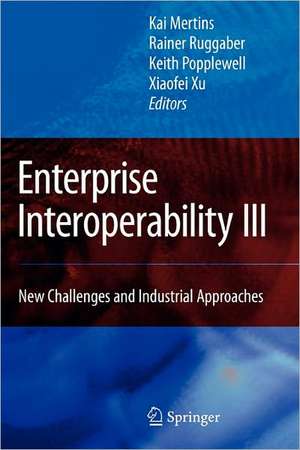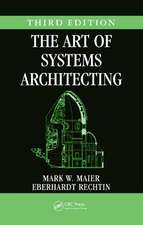Enterprise Interoperability III: New Challenges and Industrial Approaches
Editat de Kai Mertins, Rainer Ruggaber, Keith Popplewell, Xiaofei Xuen Limba Engleză Paperback – 13 oct 2010
Composed of over 50 papers, Enterprise Interoperability III ranges from academic research through case studies to industrial and administrative experience of interoperability. The international nature of the authorship continues to broaden. Many of the papers have examples and illustrations calculated to deepen understanding and generate new ideas.
A concise reference to the state of the art in software interoperability, Enterprise Interoperability III will be of great value to engineers and computer scientists working in manufacturing and other process industries and to software engineers and electronic and manufacturing engineers working in the academic environment.
| Toate formatele și edițiile | Preț | Express |
|---|---|---|
| Paperback (1) | 1835.39 lei 6-8 săpt. | |
| SPRINGER LONDON – 13 oct 2010 | 1835.39 lei 6-8 săpt. | |
| Hardback (1) | 1841.85 lei 6-8 săpt. | |
| SPRINGER LONDON – 25 mar 2008 | 1841.85 lei 6-8 săpt. |
Preț: 1835.39 lei
Preț vechi: 2238.29 lei
-18% Nou
Puncte Express: 2753
Preț estimativ în valută:
351.19€ • 367.67$ • 290.60£
351.19€ • 367.67$ • 290.60£
Carte tipărită la comandă
Livrare economică 05-19 aprilie
Preluare comenzi: 021 569.72.76
Specificații
ISBN-13: 9781849967587
ISBN-10: 184996758X
Pagini: 712
Ilustrații: XIII, 696 p.
Dimensiuni: 155 x 235 x 37 mm
Greutate: 0.98 kg
Ediția:Softcover reprint of hardcover 1st ed. 2008
Editura: SPRINGER LONDON
Colecția Springer
Locul publicării:London, United Kingdom
ISBN-10: 184996758X
Pagini: 712
Ilustrații: XIII, 696 p.
Dimensiuni: 155 x 235 x 37 mm
Greutate: 0.98 kg
Ediția:Softcover reprint of hardcover 1st ed. 2008
Editura: SPRINGER LONDON
Colecția Springer
Locul publicării:London, United Kingdom
Public țintă
ResearchCuprins
Business and Strategies, Cases.- An Approach for the Evaluation of the Agility in the Context of Enterprise Interoperability.- Industrialization Strategies for Cross-organizational Information Intensive Services.- SME Maturity, Requirement for Interoperability.- Information Security Problems and Needs in Healthcare — A Case Study of Norway and Finland vs Sweden.- Impact of Application Lifecycle Management — A Case Study.- Cross-organizational Collaboration and Cross-sectoral Processes.- A Service-oriented Reference Architecture for Organizing Cross-Company Collaboration.- Patterns for Distributed Scrum — A Case Study.- Understanding the Collaborative Workspaces.- Models and Methods for Web-support of a Multi-disciplinary B2(B2B) Network.- Platform Design for the B2(B2B) Approach.- Trust and Security in Collaborative Environments.- Prototype to Support Morphism between BPMN Collaborative Process Model and Collaborative SOA Architecture Model.- Heterogeneous Domains’ e-Business Transactions Interoperability with the use of Generic Process Models.- Matching of Process Data and Operational Data for a Deep Business Analysis.- Methods for Design of Semantic Message-Based B2B Interaction Standards.- Service Design and Execution.- An Adaptive Service-Oriented Architecture.- FUSE: A Framework to Support Services Unified Process.- Adopting Service Oriented Architectures Made Simple.- Making Service-Oriented Java Applications Interoperable without Compromising Transparency.- A Service Behavior Model for Description of Co-Production Feature of Services.- An Abstract Interaction Concept for Designing Interaction Behaviour of Service Compositions.- Preference-based Service Level Matchmaking for Composite Service.- Ontological Support in eGovernment Interoperability throughService Registries.- Towards Secured and Interoperable Business Services.- Ontologyies and Semantics for Interoperability.- Semantic Web Services based Data Exchange for Distributed and Heterogeneous Systems.- Ontology-driven Semantic Mapping.- Self-Organising Service Networks for Semantic Interoperability Support in Virtual Enterprises.- Semantic Service Matching in the Context of ODSOI Project.- Ontology-based Service Component Model for Interoperability of Service Systems.- Supporting Adaptive Enterprise Collaboration through Semantic Knowledge Services.- Interoperability in Systems Engineering.- Semantic Web Framework for Rule-Based Generation of Knowledge and Simulation of Manufacturing Systems.- Semantic Interoperability Requirements for Manufacturing Knowledge Sharing.- Collaborative Product Development: EADS Pilot Based on ATHENA.- Contribution to Knowledge-based Methodology for Collaborative Process Definition: Knowledge Extraction from 6napse Platform.- SQFD: QFD-based Service Quality Assurance for the Lifecycle of Services.- Coevolutionary Computation Based Iterative Multi-Attribute Auctions.- Knowledge Integration in Global Engineering.- Modelling and Meta-modelling Methods and Tools for Interoperability.- A Framework for Executable Enterprise Application Integration Patterns.- Experiences of Tool Integration: Development and Validation.- Interoperability — Network Systems for SMEs.- Engineer to Order Supply Chain Improvement Based on the GRAI Meta-model for Interoperability: An Empirical Study.- Proposal for an Object Oriented Process Modeling Language.- Enterprise Modeling Based Application Development for Interoperability Problem Solving.- IS Outsourcing Decisions: Can Value Modelling Be of Help?.- Process Composition in Logistics: An OntologicalApproach.- Interoperability of Information Systems in Crisis Management: Crisis Modeling and Metamodeling.- A Novel Pattern for Complex Event Processing in RFID Applications.- Architectures and Frameworks for Interoperability.- Enterprise Architecture: A Service Interoperability Analysis Framework.- Logical Foundations for the Infrastructure of the Information Market.- Meeting the Interoperability Challenges of eTransactions among Heterogeneous Business Partners: The Advantages of Hybrid Architectural Approaches for the Integrating Middleware.- A Model-driven, Agent-based Approach for a Rapid Integration of Interoperable Services.- BSMDR: A B/S UI Framework Based on MDR.- A Proposal for Goal Modelling Using a UML Profile.
Textul de pe ultima copertă
In the context of enterprise applications, interoperability is the ability of a system or an organisation to work seamlessly with other systems or organisations without any special effort. This ability to interact and exchange information both internally and with external organisations (partners, suppliers and/or customers) is a key issue in the global economy. It is fundamental to the acceleration of the production of goods and services at lower cost at the same time as ensuring higher levels of quality and customisation. Despite the last decade’s many efforts to overcome interoperability barriers in industry, non-interoperability still causes an enormous cost for all business partners. Studies show that more than 40% of IT costs are devoted to the solution of interoperability problems. This book provides knowledge for cost savings and business improvement as well as new technical solutions.
Composed of over 50 papers, Enterprise Interoperability III ranges from academic research through case studies to industrial and administrative experience of interoperability. The international nature of the authorship continues to broaden. Many of the papers have examples and illustrations calculated to deepen understanding and generate new ideas.
The I-ESA’08 conference from which this book is drawn was sponsored by the Interop-VLab and the Enterprise Interoperability Center (EIC). It is also supported by the International Federation for Information Processing and various national associations.
A concise reference to the state of the art in software interoperability, Enterprise Interoperability III will be of great value to engineers and computer scientists working in manufacturing and other process industries and to software engineers and electronic and manufacturing engineers working in the academic environment.
Composed of over 50 papers, Enterprise Interoperability III ranges from academic research through case studies to industrial and administrative experience of interoperability. The international nature of the authorship continues to broaden. Many of the papers have examples and illustrations calculated to deepen understanding and generate new ideas.
The I-ESA’08 conference from which this book is drawn was sponsored by the Interop-VLab and the Enterprise Interoperability Center (EIC). It is also supported by the International Federation for Information Processing and various national associations.
A concise reference to the state of the art in software interoperability, Enterprise Interoperability III will be of great value to engineers and computer scientists working in manufacturing and other process industries and to software engineers and electronic and manufacturing engineers working in the academic environment.
Caracteristici
Keeps the reader up-to-date with developments in a field which is extremely important for industrial competitiveness International author pool means that readers can learn about the environment in many countries with which they may have to co-operate Inter-disciplinary subject matter allows the reader to learn about many points of view on similar problems Includes supplementary material: sn.pub/extras











